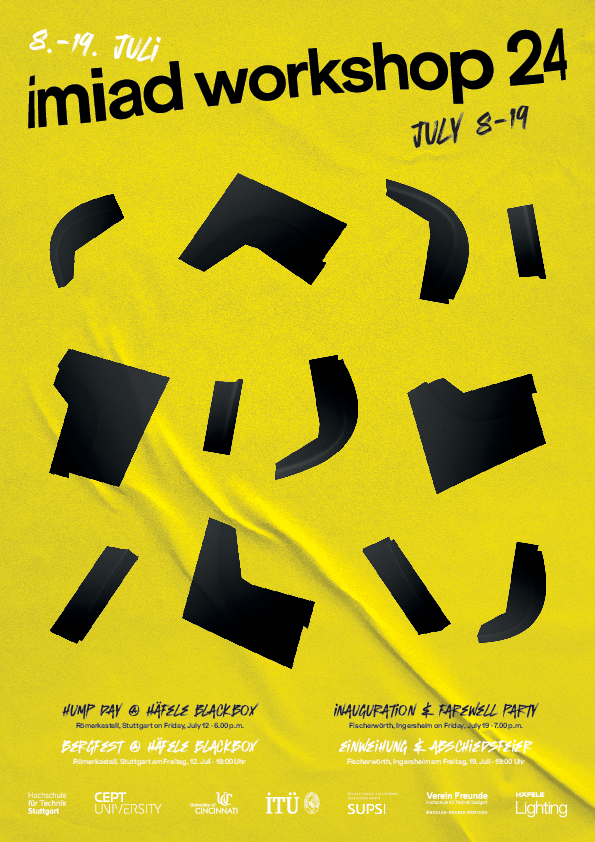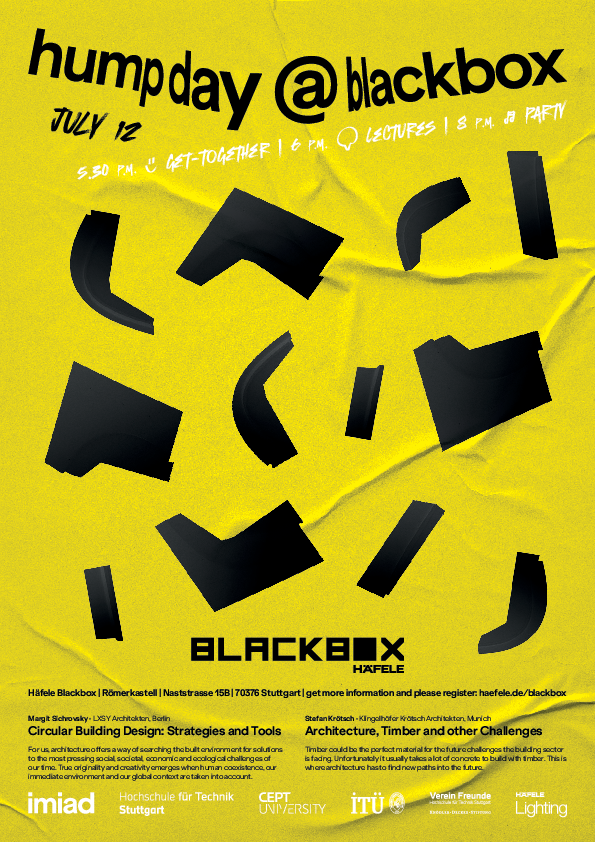IMIAD International Workshop 2024 at the Stuttgart University of Applied Sciences
In a two-week international Design Build Workshop with around 50 students and lecturers from HFT Stuttgart and the partner universities CEPT Ahmedabad/India and ITÜ Istanbul/Turkey, the International Master of Interior-Architectural Design (imiad) program contributed to the realization of the first living lab in the research project "Stuttgart 210 - think ahead, build on!" in July 2024.
The international workshop is organized every summer by one of the five partner universities in the Interior Architecture degree program: Stuttgart University of Applied Sciences (Germany), Scuola Universiteria Professionale Della Svizzera (Mendrisio, Switzerland), The Center for Environmental Planning and Technology University (Ahmedabad, India), University of Cincinnati (USA), Istanbul Technical University (Turkey).
Living lab "Ingersheim Youth Hangout"
In contrast to conventional summer schools at architecture faculties, the workshop did not take place in a drawing room or seminar room. All participants had the opportunity to participate in the realization of a real construction project, as the international workshop in summer 2024 was linked to the research project “Stuttgart 210 - think ahead, build on!”. A team of architects and engineers from the universities of Constance, Stuttgart and Karlsruhe are working with proHolz Baden-Württemberg to repurpose concrete formwork from the construction site of the new main railway station in Stuttgart and are investigating ways to reuse these building materials as part of various living labs (upcycling).The Ingersheim youth hangout is the first of four living labs whose design is characterized by a spectacular interior space that is shaped by the wooden surfaces of the cleaned formwork elements. Formwork elements of the southern tunnel exits made of 8-axis milled, multi- and cross-laminated timber form the supporting structure and interior space. The building is protected from the weather by an oval shell made of spruce boards and battens. This not only preserves the amazing geometry and wooden surface of the high-tech formwork, but also binds the CO2 stored in the wood and removes it from the atmosphere.
The workshop was organized by Prof. Andreas Kretzer, partner in the research project, and Dipl.-Des. Melissa Acker in close cooperation with the municipality of Ingersheim. Many thanks to the Verein der Freunde der HFT, the Knödler-Decker Foundation, Häfele, Würth and all other project partners, volunteers and participating companies.
More information on "Stuttgart 210 think ahead - build ahead!"
stuttgart210.de
Preparation of the formwork elements
Any boat varnish that had formed the formwork surface for the concreting (and also preserved the elements) was removed manually using electric planers. This process and the subsequent treatment with parquet and orbital sanders revealed a unique wooden surface that has a Damascus steel-like structure due to the amorphous, three-dimensional milling of the parallel layers of the cross laminated timber.
Design Build Workshop
During the two-week workshop, more than forty Turkish, Indian and German students from the Master's degree programme in Interior Architecture at the Stuttgart University of Applied Sciences prefabricated and assembled the oval shell made of spruce boards and strips. The group of students also fine-tuned the surfaces of the formwork elements and the benches, worked out the fits and filled in the gaps. The municipality, the local German Red Cross association, the Ingersheim sports clubs and local volunteers supported the accommodation and catering for the workshop participants.
BERGFEST @ HÄFELE BLACKBOX
Halfway through the workshop, a lecture evening with impulses on circular building and the future of timber construction took place on Friday, 12 July, from 6 p.m. in the HÄFELE BLACKBOX in the Römerkastell Stuttgart.
Lectures
Prof. Margit Sichrovsky | LXSY Architekten, Berlin | HFT Stuttgart
Circular Building: Strategies and tools
For us, architecture offers an opportunity to search for solutions in the built environment to the most pressing social, societal, economic and environmental challenges of our time. True originality and creativity emerge when human coexistence, our immediate surroundings and our global context are taken into account.
Prof. Stefan Krötsch | Klingelhöfer Krötsch Architekten, Munich | HTWG Konstanz
Architecture, wood and other challenges
Wood could be the perfect material for future challenges in the construction sector. Unfortunately, you usually need a lot of concrete to build with wood. This is where architecture needs to find new ways into the future.
Venue
Häfele Blackbox, Römerkastell, Naststrasse 15B, 70376 Stuttgart
Poster
Download
INAUGURATION & FAREWELL PARTY
At the end of the workshop, a farewell party was held in Ingersheim on Friday 19 July with all helping hands, cooperation partners and interested parties from the community.
Venue
Fischerwörth, Ingersheim
Poster
Download poster
Further information and publications
Website Gemeinde Ingersheim - living lab: Re-Use S210 youth centre
Report in BEZUG MAGAZIN, NOVEMBER 2024 | ISSUE 42, publisher: Bahnprojekt Stuttgart-Ulm e.V.
Article in the magazine – Die Architekt – of the BDA, No. 6 2024
baunetz Campus: Ausgedient, aber nicht verloren: Reallabor schenkt Betonschalungen ein zweites Leben
archdaily: Stuttgart 210 Living Lab Ingersheim Pilot Project / HFT Stuttgart - HTWG Konstanz
CRADLE: Visionary Architecture: How a Youth Center Was Created from Construction Waste
DAB Nachwuchs-Kolumne #239: Stuttgart 210: Upcycling im Großformat mit Schalungen
DIVISARE: Stuttgart 210 Living Lab Ingersheim Pilot Project
![[Image: Klaus Mellenthin] Blick in Luftraum mit großem Tisch, an dem Studierende arbeiten](/fileadmin/Dateien/Architektur-Gestaltung/_processed_/0/e/csm_fak-a-basic-page-coverbild_85808f2556.jpg)
![[Image: © Achim Birnbaum]](/fileadmin/Dateien/Architektur-Gestaltung/_processed_/a/b/csm_S210-AB-Ingersheim-34_bc1d78e9eb.jpg)
![[Image: HFT]](/fileadmin/Dateien/Architektur-Gestaltung/_processed_/b/b/csm_04-Baubeginn_5e8bb18411.jpg)
![[Image: HFT / Vishal Joshi]](/fileadmin/Dateien/Architektur-Gestaltung/_processed_/3/3/csm_05-Baubeginn_a100a7e704.jpg)
![[Image: Forschungsteam Stuttgart210]](/fileadmin/Dateien/Architektur-Gestaltung/_processed_/f/0/csm_S210-Ingersheim-EG-1zu20_73046c74f3.jpg)
![[Image: Forschungsteam Stuttgart210]](/fileadmin/Dateien/Architektur-Gestaltung/_processed_/b/3/csm_S210-Ingersheim-Sprengisometrie_15f1188d55.jpg)
![[Image: HFT / Georg Zimmer]](/fileadmin/Dateien/Architektur-Gestaltung/_processed_/9/1/csm_01-Vorbereitung_8fd1660775.jpg)
![[Image: HFT / Georg Zimmer]](/fileadmin/Dateien/Architektur-Gestaltung/_processed_/d/4/csm_02-Vorbereitung_9d224a63a2.jpg)
![[Image: Andreea Ghit / HFT Stuttgart]](/fileadmin/Dateien/Architektur-Gestaltung/_processed_/6/8/csm_imiad-workshop24_studierende_01_andreea-ghit_851bfa05f4.jpg)
![[Image: Melissa Acker / HFT Stuttgart]](/fileadmin/Dateien/Architektur-Gestaltung/_processed_/1/e/csm_imiad-workshop24_studierende_02_melissa-acker_b39da541d1.jpg)
![[Image: Andreea Ghit / HFT Stuttgart]](/fileadmin/Dateien/Architektur-Gestaltung/_processed_/8/1/csm_imiad-workshop24_studierende_03_andreea-ghit_fd744a7363.jpg)
![[Image: Katharina Raabe / HFT Stuttgart]](/fileadmin/Dateien/Architektur-Gestaltung/_processed_/3/7/csm_imiad-workshop24_studierende_04_katharina-raabe_a51ec234d2.jpg)
![[Image: Sayali Katkar / HFT Stuttgart]](/fileadmin/Dateien/Architektur-Gestaltung/_processed_/b/a/csm_imiad-workshop24_studierende_05_sayali-katkar_d41e5f291f.jpg)
![[Image: Sayali Katkar / HFT Stuttgart]](/fileadmin/Dateien/Architektur-Gestaltung/_processed_/9/a/csm_imiad-workshop24_studierende_06_sayali-katkar_15df1cdec6.jpg)
![[Image: Muge Ozkan (1) & Elif Ezgi Karatas (2-4) / HFT Stuttgart]](/fileadmin/Dateien/Architektur-Gestaltung/_processed_/6/1/csm_imiad-workshop24_studierende_07_muge-ozkan_elif-ezig-karatas_51342bf772.jpg)


![[Image: Victor S. Brigola]](/fileadmin/Dateien/Architektur-Gestaltung/_processed_/9/6/csm_VSB_2024-07-12_343_50182ba939.jpg)
![[Image: Victor S. Brigola]](/fileadmin/Dateien/Architektur-Gestaltung/_processed_/f/0/csm_VSB_2024-07-12_205_c0b55b1816.jpg)
![[Image: Victor S. Brigola]](/fileadmin/Dateien/Architektur-Gestaltung/_processed_/d/d/csm_VSB_2024-07-12_389_4c3d089723.jpg)
![[Image: Victor S. Brigola]](/fileadmin/Dateien/Architektur-Gestaltung/_processed_/d/4/csm_VSB_2024-07-12_440_8412513938.jpg)
![[Image: Victor S. Brigola]](/fileadmin/Dateien/Architektur-Gestaltung/_processed_/3/9/csm_VSB_2024-07-12_527_34e408535d.jpg)
![[Image: Victor S. Brigola]](/fileadmin/Dateien/Architektur-Gestaltung/_processed_/0/0/csm_VSB_2024-07-12_384_955cf6af8a.jpg)
![[Image: Victor S. Brigola]](/fileadmin/Dateien/Architektur-Gestaltung/_processed_/7/8/csm_VSB_2024-07-12_897_75fb75dacd.jpg)
![[Image: Victor S. Brigola]](/fileadmin/Dateien/Architektur-Gestaltung/_processed_/f/5/csm_VSB_2024-07-12_800_c10bb77a52.jpg)
![[Image: HFT]](/fileadmin/Dateien/Architektur-Gestaltung/_processed_/b/4/csm_11-Eroeffnung_e83f3cd4ee.jpg)
![[Image: Georg Zimmer]](/fileadmin/Dateien/Architektur-Gestaltung/_processed_/5/7/csm_12-Abschied_f64efcdcfb.jpg)
![[Image: Georg Zimmer]](/fileadmin/Dateien/Architektur-Gestaltung/_processed_/f/1/csm_427bd337-f8a8-4590-820a-c73968a3d9a0_62ece73c73.jpg)
![[Image: © Achim Birnbaum]](/fileadmin/Dateien/Architektur-Gestaltung/_processed_/9/7/csm_S210-AB-Ingersheim-07_3cfb09bfcd.jpg)
![[Image: © Achim Birnbaum]](/fileadmin/Dateien/Architektur-Gestaltung/_processed_/5/6/csm_S210-AB-Ingersheim-01_27d4d036bf.jpg)
![[Image: © Achim Birnbaum]](/fileadmin/Dateien/Architektur-Gestaltung/_processed_/8/6/csm_S210-AB-Ingersheim-05_1d09a44377.jpg)
![[Image: © Achim Birnbaum]](/fileadmin/Dateien/Architektur-Gestaltung/_processed_/4/f/csm_S210-AB-Ingersheim-22_013fc1af07.jpg)
![[Image: © Achim Birnbaum]](/fileadmin/Dateien/Architektur-Gestaltung/_processed_/5/3/csm_S210-AB-Ingersheim-15_31_6664b3c43a.jpg)
![[Image: © Achim Birnbaum]](/fileadmin/Dateien/Architektur-Gestaltung/_processed_/b/5/csm_S210-AB-Ingersheim-25_ae8b4c4a26.jpg)
![[Image: HFT Stuttgart] Abbildung einer Betonschalung](/fileadmin/Dateien/Architektur-Gestaltung/_processed_/d/a/csm_00-architektur-news-imiad-workshop-ingersheim_80106d2896.jpg)
![[Image: HFT Stuttgart] Vorbereitung – IMIAD Workshop Ingersheim](/fileadmin/Dateien/Architektur-Gestaltung/_processed_/f/7/csm_01-architektur-news-imiad-workshop-vorbereitung_30d7071499.jpg)
![[Image: Andreas Kretzer / Architekturquartett Ludwigsburg]](/fileadmin/Dateien/Architektur-Gestaltung/_processed_/e/1/csm_Collage-Architekturquartett-48-Reallabor-Ingersheim_ba69bc6d12.jpg)
![[Image: HFT Stuttgart] Grafik für die Ausstellung "aus Schalen entworfen"](/fileadmin/Dateien/Architektur-Gestaltung/_processed_/c/4/csm_04-architektur-gestaltung-ausstellung-aus-schalen-entworfen_613527b47e.jpg)
![[Image: HFT Stuttgart] Dokumentation der Ausstellung "Aus Schalen entworfen" im StadtPalais](/fileadmin/Dateien/Architektur-Gestaltung/_processed_/c/b/csm_00-architektur-gestaltung-nachbericht-ausstellung-aus-schalen-entworfen_e005044228.jpg)
![[Image: HFT Stuttgart] Ausstellung aus Von Schalen entworfen an der HFT Stuttgart in Bau 1](/fileadmin/Dateien/Architektur-Gestaltung/_processed_/5/1/csm_01-architektur-gestaltung-ausstellung-hft-stuttgart-aus-schalen-entworfen_84d6478a59.jpg)